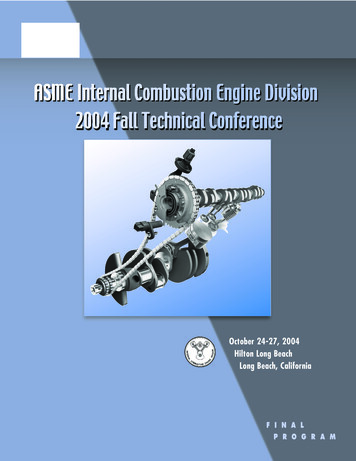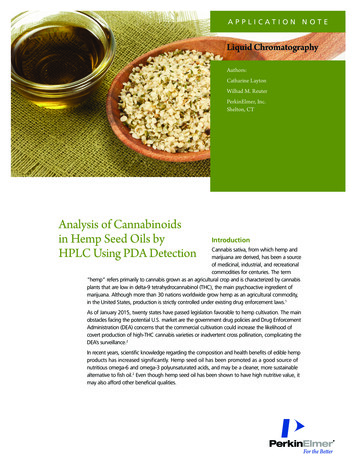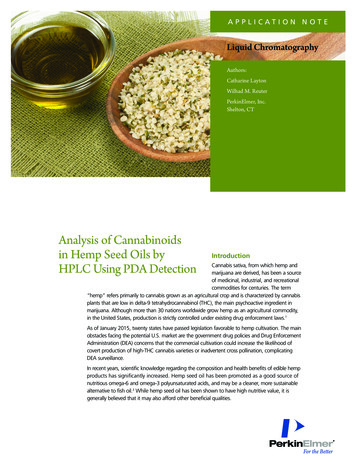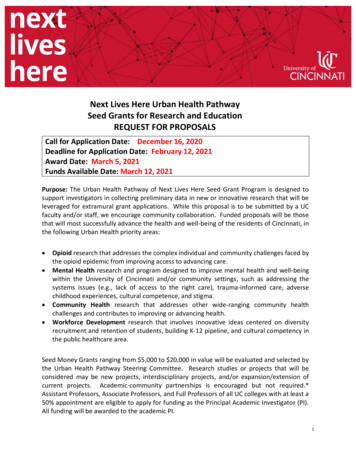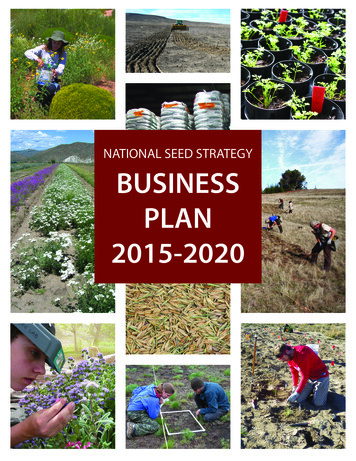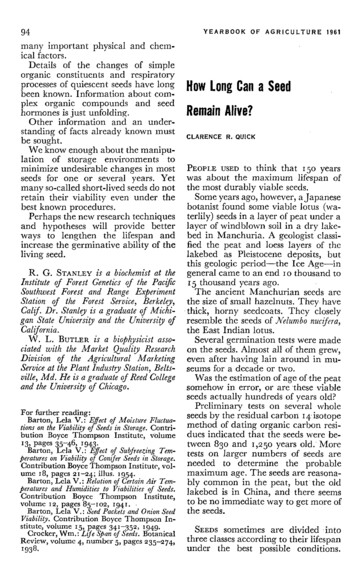
Transcription
94many important physical and chemical factors.Details of the changes of simpleorganic constituents and respiratoryprocesses of quiescent seeds have longbeen known. Information about complex organic compounds and seedhormones is just unfolding.Other information and an understanding of facts already known mustbe sought.We know enough about the manipulation of storage environments tominimize undesirable changes in mostseeds for one or several years. Yetmany so-called short-lived seeds do notretain their viability even under thebest known procedures.Perhaps the new research techniquesand hypotheses will provide betterways to lengthen the lifespan andincrease the germinative ability of theliving seed.R. G. STANLEY is a biochemist at theInstitute oj Forest Genetics oj the PacificSouthwest Forest and Range ExperimentStation oj the Forest Service, Berkeley,Calif. Dr. Stanley is a graduate oj Michigan State University and the University ojCalifornia.W. L. BUTLER is a biophysicist associated with the Market Quality ResearchDivision oj the Agricultural MarketingService at the Plant Industry Station, Beltsville, Md. He is a graduate of Reed Collegeand the University oj Chicago.For further reading:Barton, Lela V.: Effect qf Moisture Fluctuations on the Viability oj Seeds in Storage. Contribution Boyce Thompson Institute, volume13, pages 35-46, 1943.Barton, Lela V.: Effect qf Subjreezing Temperatures on Viability oj Conifer Seeds in Storage.Contribution Boyce Thompson Institute, volume 18, pages 21-24; illus. 1954.Barton, Lela V.: Relation of Certain Air Temperatures and Humidities to Viabilities qf Seeds.Contribution Boyce Thompson Institute,volume 12, pages 85-I02, 1941. "Barton, Lela V.: Seed Packets and Onion SeedViability. Contribution Boyce Thompson Institute, volume 15, pages 341-352, 1949.Crocker, Wm.: Life SPan of Seeds. BotanicalReview, volume 4. number 5. pages 235-274.1938.YEARBOOK OF AGRICULTURE 1961How Long Can a SeedRemain Alive?CLARENCE R. QUICKPEOPLE USED to think that 150 yearswas about the maximum lifespan ofthe most durably viable seeds.Some years ago, however, aJapanesebotanist found some viable lotus (waterlily) seeds in a layer of peat under alayer of windblown soil in a dry lakebed in Manchuria. A geologist classified the peat and loess layers of thelakebed as Pleistocene deposits, butthis geologic period-the Ice Age-ingeneral came to an end 10 thousand to15 thousand years ago.The ancient Manchurian seeds arcthe size of small hazelnuts. They have"thick, horny seedcoats. Thcy closelyresemble the seeds of Nelumbo nucifera,the East Indian lotus.Several germination tests were madeon the seeds. Almost all of them grew,even after having lain around in museums for a decade or two.Was the estimation of age of.the peatsomehow in error, or are these viableseeds actually hundreds of years old?Preliminary tests on several wholeseeds by the residual carbon I4 isotopemethod of dating organic carbon residues indicated that the seeds were between 830 and I,250 years old. Moretests on larger numbers of seeds areneeded to determine the probablemaximum age. The seeds are reasonably common in the peat, but" the oldlakebed is in China, and there seemsto be no immediate way to get more ofthe seeds.SEEDS sometimes are divided" intothree classes according to their lifespanunder the best possible conditions.
HOW. LONG CA N A SEED REM AI N ALIVE?Seeds may be microbiotic (a lifespanof less than 3 years), mesobiotic (3 to15 years), or macrobiotic (more than15 years).Such a classification is convenientbut arbitrary. It assumes that we knowthe optimum conditions for preservation of viability in many kinds of seeds,but that is not entirely correct, evenfor the many economically importantkinds of seeds.Many-perhaps most-kinds of seedsof Temperate Zone wild plants arebest preserved if they are carefully andthoroughly dried, placed in airtightcontainers, and stored under moderaterefrigeration.M'any others, particularly seeds ofnumerous plants of the wet Tropics,would be killed by this treatment.Some seeds are dead if they becomethoroughly dry. Immature seeds andseeds from diseased or otherwise unvigorous plants commonly have lesslongevity than more normal seeds.Obviously, adequate methods forstorage and adequate methods forgermination must be known specifically before maximum longevity of seedcan be approximated.Most of our knowledge of longevityof seed comes from germination testswith three general types of stored seedsamples: Seeds recovered from plannedlength-of-storage tests, "finds" of oldseed samples, and old herbarium collections. The third method has led tovaluable results, but it is not generallyrecommended, especially by herbarium curators! Collection data and storage conditions, furthermore, are notlikely to be known so explicitly forseeds from herbarium samples andfrom finds of old samples.Carefully planned length-of-storagetests have been made on many speciesof seeds and under many conditions ofstorage. Storage conditions and testsare highly important, especially forcrop seeds. In this chapter I discussonly the tests that resulted in germination of seeds of ages well beyond common lengths of commercial storage ofcrop seeds.95Paul Becquerel, a French botanist,in 1907 and again in 1934 gave reportson germination tests on about 500species of old seeds from a storage roomin a museum. Of 13 species of viableseeds more than 50 years old, I Ispecies were legumes. Two species ofCassia (Leguminosae), one with seedsviable after 158 years and one afterI 15 years, were outstanding.A. ]. Ewart, an Australian, in 1908reported tests on some 1,400 speciesand varieties of old seeds. Of the 49samples of viable seeds more than 50years old, 37 were legumes. Seeds ofone species each of Hovea and of Goodiawere viable after 105 years. Bothplants are legumes.J. H. Turner, Kcw Gardens, England, in 1933 reported viable seeds insamples of seven species of legumesthat were 80 or more years of age.The genera were Antkvllis, Cytisus,Lotus, Medicago, Melilotus, and Trifolium.The Gardeners' Chronicle, London,in 1942 reported viable seeds ofAlbizziajulibrissin (a legume) after 149years of storage and of Nelumbium speciosum (a waterlily) after about 250years.Many other germination tests on oldseeds have been reported.Frits W. Went, of the CaliforniaInstitute of Technology, and Philip A.Munz, of Rancho Santa Ana BotanicGarden, Calif., in 1948 started anelaborate longtime longevity test onseeds of more than 100 native California plants. Samples were dried invacuum desiccators, packed in smallglass tubes (20 tubes per seed sample),evacuated in the tubes to 0.1 millimeter of mercury or less, sealed, andplaced in an insulated but unrefrigera ted storage room. It is proposedthat the last set of these samples betested for germination in A.D. 2307.V'Ve used to read reports that plantsgrew from "mummy" grains and peasefound in ancient Egyptian tombs. Itwas also suggested somewhat later thatviable seeds of Silene (a pink) and ofGlaucium (a poppy) may have re-
96mained dormant for some 2 thousandyears in the soil under heaps of ancientmining and smelting debris in theLam'ian area of Greece.Seed physiologists now consider allsuch claims erroneous. In all tests ofauthentic seed from Egyptian tombs,the seeds were dead. They disintegrated promptly.FARMERS know that weed seeds canremain viable but dormant for manyveal'S in clean-cultivated land. Seeds f many garden plants react similarlyto burial.Seedlings of certain plants growabundantly around old cow pads inpastures, an indication that some seedscan pass through the digestive systemof grazing animals and remain viable,possibly to contaminate clean pastures.Sheep, horses, deer, bear, and rabbitsare known to pass viable seeds. Somebirds scatter many kinds of viableseeds. Other plant-eating and fruiteating animals are presumed to do thesame. Topsoil of fields and wildlandscomes to contain considerable populations of viable seeds.For example, 800 seedlings of fieldbindweed per acre emerged in 1941in a 14-acre field, from which theoriginal stand of bindweed had beeneradicated in 1921. No bindweedplants had been permitted to fruitduring the intervening period.The plant ecologist, the farmer, andthe seed physiologist are interested inthese "soil-stored seeds" because oftheir importance to the long persistence of plant species that are thusscattered in time as well as in space.The forest floor under stands of mature timber often contains surprisingnumbers of viable seeds. One study inMaine indicated a total viable seedpopulation of 650 thousand per acre.A research worker in Californiafound 2,820 thousand viable seeds peracre. Seeds of trces in ecologically climax vegetation are seldom found inabundance in these studies.Seeds and other plant residues inadobe buildings in the Southwest andYEARBOOK OF AGRICULTURE 1961sod houses in the Midwest have beenstudied to estimate seed longevity andto date the introduction of weeds.Drastic disturbances to the soil mantle, such as war bombings, often havecaused seedlings of plant species toemerge in unexpected places.The knowledge that some seeds remain viable in soil for decades stimulated several extensive buried-seed experiments. Investigators mixed seedsof known species, age, and conditionwith sand or soil and packed them inreplicated bottles. They buried thebottles, mouth downwards, at one orseveral depths below the soil surface.They removed one or a set of bottles atplanned intervals for testing. The remaining bottles were kept undisturbed.These buried-seed tests simulate, butdo not necessarily duplicate, environmental conditions of seeds naturallystored in the soil. One big advantageof the planned tests is that the age ofthe seed is known precisely.Prof. W. J. Beal, of the State University of Michigan, started"one of theearliest of these tests. He buried 20 pintbottles of weed seeds mixed with sandin the autumn of 1879. Each bottlecontained 50 seeds each of 20 kinds ofweedy plants. He buried the 20 bottles,with mouths tilted downward, 18inches below the soil surface.After 40 years in the soil, but notafter 50 years, seeds of the followingfive plants were still viable: Amaranthusretroflexus (pigweed), Ambrosia dalior(ragweed), Lepidium virginicum (peppergrass), Plantago major (plantain), andPortulaca oleracea (purslane).After 40 and 50 years, but not after60 years, two additional species grew:Brassica nigra (mustard) and Polygonumhydropiper (knotweed).After 40, 50, and 60 years, but notafter 70 years, Silene noctiflora (eatchfly)grew.And after 70 years, three specieswere still germinable: Oenothera biennis(evening-primrose), Rumex crispus (adock), Verbascum blattaria (mullein).J. W. T. Duvel, of the Department ofAgriculture, in 1902 buried multiple
HOW LONG CAN A SEED REMAIN ALIVE?sets of seeds of I07 species of wild andcultivated plants near Rosslyn, Va. Hepacked the seeds in sterile soil in flowerpots covered with porous clay lidsand buried the pots in the open atthree depths-8, 22, and 42 inches.Sets of seeds were removed periodicallyand tested for germination.Of the 107 species buried in 1902,7 I grew after I year, 6 I after 3 years,68 after 6 years, 68 after 10 years, 5 Iafter 16 years, 5 I after 20 years, 44after 30 years, and 36 after 39 years.The tests were discontinued with the39-year-old set of pots dug up in 194 I.W. L. Goss, of the California Department of Agriculture, in 1932 buriedsamples of seeds of 12 troublesomeweeds. Seeds of bindweed (Convolvulusarvensis) , a nightshade (Solanum elaeagnifolium) , and Klamathweed (lljpericum perforatum) were the only ones viable after 10 years.FROM THE MANY experiments andobservations on seed longevity, we cannow draw some generalizations interms of seed morphology and chemistry and in terms of plant ecology andtaxonomy.Seeds vary widely in size. The cocode mer, a coconut of Praslin Island,Seychelles group, Indian Ocean, iscredited with a maximum fruit weightof 40 to 50 pounds. The air-dry seedsof a small American plant in the figwort family (Ilysanthes dubia) are saidto run about 137 million per pound.In the Temperate Zone, large, heavyseeds tend to be few and long lived,and small, easily distributed seeds tendto be numerous but short lived.The number of seeds produced perplant also varies enormously. Relatively few seeds are produced by acoconut palm, but it has been estimated that one plant of Amaranthusgraecizans, an annual tumbleweed, mayproduce as many as 6 million seeds.Seedcoats are important in thelongevity of seed. Seedcoats of mostlong-lived seeds have on or near theoutside a palisade, or a Malpighian,layer made up of heavy-walled, tightly556S88 -Cl--897packed, radially placed, columnarcells. The cells are hard and horny.Usually they are lignified or cutinized.There are no intercellular spaces.The palisade layer is mechanicallyprotective and highly impervious towater and to respiratory gases. 10r phologically, it is the most importantstructure in seed longevity; most seedswith exceptional longevity have a welldeveloped palisade layer. This layer isnot so all-important to buried seeds orto soil-stored seeds, because the soilhabitat apparently provides some ofthe same or similar protective conditions necessary to longevity.Little need be said here about seedextraction, cleaning, and storage, except to point out that the least damaged seeds-mechanically and biologically-and the best stored seedswill have the greatest longevity.Many seeds with marked longevitylook much alike. Typically they arelarger and heavier than the average.Coats are thick and hard and oftenhave a smooth, polished surface. Theseeds commonly will not plump ifsoaked in cold water.Some examples of well-known nativemacrobiotic seeds are: Gymnodadusdioicus (Kentucky coffeetree), about240 seeds to the pound; Gleditsia triacanthos (honeylocust), about 2,840seeds to the pound; Robinia pseudoacacia (black locust), about 25 thousandseeds; Ceanotlzus cuneatus (buck brush),about 55 thousand seeds; and Lotusamericanus (deervetch), about 110 thousand seeds to the pound.Seeds of cultivated plants long usedin their entirety as food commonlyhave thinner and weaker coats thanclosely related wild plants. The foodseeds generally are shorter lived.The chemical composition of manycrop seeds, but few others, is wellknown. Seeds are sometimes classifiedbroadly according to the kind of foodreserves they store, as starchy seeds(such as those of the Gramincae, thegrass family); proteinaceous seeds (forexample, those of the Lcguminosae,the legumes); and oily seeds (from
98most trce nuts and many other plants).The classification is arbitrary, because the food reservcs of seeds commonly are mixtures of various carbohydrates, proteins, and fats. I knowof no comprehensive Eng'lish summaryof the chemical characteristics of seeds.The longevity of the oily seeds ofsugar pine (Pinus lambertiana) is relatedclosely to the kind and amount ofunsaturated fatty acids in the seeds.Another suggestion is that rancidity ofseed fats in pine and other seeds variesinversely with seed viability.The degeneration of proteins in foodgrains roughly parallels reduction ofseed viability.Some biochemical aspects of seedviability are known, but the precisereasons for loss of viability-death ofthe seed-are not yet clear.The amazing thing about seeds isnot that they degenerate with timebut that some deteriorate so slowly.One theory for the dcgenerationof long-lived seeds suggests that thevarious proteins slowly coagulate anddenature with time and eventuallycannot function in germination.A related theory-perhaps the mostplausible one in the present state of ourknowledge--is that loss of viability isdue to gradual degeneration, in thenuclei of cells, of the chromatin-thematerial basis of heredity-and of thedelicatc mechanism for mitosis, theprocess by which cells divide and increase in number.Experiments that support this secondtheory show that aging, heating, andX-ray treatment of dry seeds all causesimilar degeneration-increased mitotic aberrations and chromosomechangcs and increased plant mutationsand abnormalities.Degrees of aging and of treatmentcause more or less proportional increases in extent of abnormalities andmutations until all viability is lost. Anextension of this theory is that the mutations resulting from aged seeds is onemeans by which Nature producesvarying races and strains of plants andadvances evolution.YEARBOOK OF AGRICULTURE 1961Seed longevity in a broad sense is anecologic characteristic of a plant aswcll as a morphologic and a biochemical one. Over the great reaches of geologic time, the biology of most plantspecies and their seeds has come to fitapproximately the habitat in whichthey are characteristically found.Some plants are primary pioneers.They grow most commonly on ecologically tough sites where soil is scarceor poor.Other plants are secondary pioneers.They are found commonly in abundance on well-developed soil profilesfrom which much or all of the prcviousplant cover has been removed by fire,logging, or clearing. And of coursethere are other comparable ecologictypes of plants.What about the life history of thosesecondary pioneers that are killed outright by fire but produce heavy seedsnot scattered by wind?How are these plants able to revegetate a burned area promptly andabundantly, as thcy so often do? Simply because they have mechanicallydurable, heat-resistant, and long-livedseeds.In studies of soil-stored seed underecologically mature forests, it is common to find more seeds of the pioneervegetation, largely displaced by ecologic development, than of the climaxtrce species. Thcre is an obvious andessential ecologic value to pioneerplants from long-lived seeds-that is,from seeds well distributed in time.A few plants produce two kinds ofseeds according to season and physiologic status of the plant. An examplc isHalogeton glomeratus, a serious weed ofwildland desert ranges. One kind ofseed will germinate immediately uponmaturity. The second kind is dormantand will not germinate until some timeafter maturity. This again is distribution of seeds in time, with seed longevity as one requirement fo-r success ofthe process.Plants (particularly woody plants)characteristic of arid climates are believed in general to have longer lived
UNTIL TIME AND PLACE ARE SUITABLEseeds than plants of tropical or ofhumid-temperate habitats.Plant taxonomy in relation to seedlongevity is another interesting field ofinquiry. The taxonomic plant families-for example, the Cruciferae, theRosaceae, and the Leguminosae-commonly are rather uniform in flowerstructure, type and arrangement ofleaves, and other traits.Are these plant families also uniformin seed biology, or is seed longevitymore a matter of ecology ("fit" to theenvironment) than of taxonomic relationships?Species of the Leguminosae, considered here in a broad taxonomicsense to include the Mimosaceae, haveturned up very frequently in lists oflong-lived seeds, and it seems that thisfamily has a marked tendency to longevity of seeds.Other plant families that apparentlyhave greater than average proportionsof species with exceptionally long-livedseeds include the palms, cannas, waterIiIies (lotuses), spurges, soapberries,buckthorns, mallows, and morningglories. Within a single species, varieties and strains with somewhat differing genetic constitution may vary ingermination and longevity.IN CONCLUSION, let us say that wehave a great many records-someamazing records-of long-lived seeds.Up to the present time, however, mostdata on seed longevity, particularly ofwild plants, have been consideredpiecemeal, species by species.Much more research and analysismust be done before broad generalizations can accurately relate seed longevity to an integrated consideration ofseed and plant biochemistry, physiology, morphology, taxonomy, andecology.CLARENCE R. QUICK is a forest pathologist in the Pacific Southwest Forest Experiment Station oj the U.S. Forest Service,Berkeley, Calif. Previously he was a forestecologist in the former Bureau oj Entomology and Plant Quarantine.99Until Time and PlaceAre SuitableEBEN H. TOOLE AND VIVIAN KEARNS TOOLEONE MUST KEEP in mind the place ofthe seed in the life of the plant if he isto understand the processes of germination.A seed is essentially a young plantwhose life activities are at a minimum.The drying out of the young seed as itripens on the plant brings about thisreduction of activities. The dry seedthus is in a condition' to :be . held,stored, and preserved until time andplace are suitable for the start of a newplant.Many seeds, especially crop seeds,begin to germinate as soon as they areplanted under moist conditions andthey absorb water. Thus new cornplants appear promptly when corngrains are kept over winter andplanted in moist, warm soil.The germination of other seeds, including seeds of many flowers andweeds, does not begin until specialconditions, besides moisture, are provided. Such seeds have a block orblocks to the germination processes.They do not germinate until the blocksare removed.If a crabgrass seed (Digitaria) shouldgerminate when it fell to the groundat maturity in late summer, coldweather would soon kill the youngseedlings. Special germination requirements of the freshly ripened crabgrassseed prevent it from germinating untilthe next season.Seeds with special germination requirements are called dormant (blocked). The special conditions associatedwith seed dormancy are considered inthe chapter that follows.
after 16 years, 5 I after 20 years, 44 after 30 years, and 36 after 39 years. The tests were discontinued with the 39-year-old set of pots dug up in 194 I. W. L. Goss, of t
